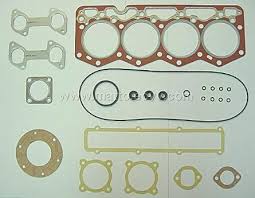Head gasket types
MLS - stands for "Multiple Layers Steel,". Most modern head engines are produced with MLS gaskets. These typically consist of three layers of steel. The contact faces are usually coated with a rubber-like coating such as Viton that adheres to the cylinder block and cylinder head while the thicker center layer is left bare.
Solid copper - A solid sheet of copper, and typically requires special machining called 'o-ringing' that places a piece of wire around the circumference of the cylinder to bite into the copper. When this is performed copper gaskets are extremely durable. Recently companies have started producing copper gaskets with integral sealing wires permitting their retrofit into engines without the removal of the engine block for machine work.
Composite -- an older technology. Typically these are made from asbestos or graphite but are more prone to blowouts than newer gaskets. Asbestos gaskets are becoming increasingly rare due to health concerns.
Elastomeric - a gasket type used by Rover on their K Series engines. It utilised a steel core plate with molded in place silicon rubber beads to seal oil and coolant passages. The bores were sealed by rolled steel fire rings in a more conventional manner. The idea behind the gasket design was to produce a production version of the technology used in F1 engines at the time. The original application of the gasket on the smaller versions of the K Series was very successful. However, an engine redesign resulted in persistent problems with the design - the joint interface became unstable and the gasket could not cope.
Gasket problems
Occasionally, the compression in the cylinder will cause a leak to form in the gasket and the gasket will have to be replaced, or severe damage can take place (a "blown" head gasket). This problem has been exacerbated by the use of aluminum rather than iron cylinder heads; while lighter than iron, aluminum has a much greater thermal expansion rate, which in turn causes a great deal more stress to be placed on the head gasket. Engine makers have responded to this by adding a non-stick coating such as Teflon to the surface of the head gasket.
If the gasket fails, a variety of problems can occur, from compression loss (leading to power reduction, or a rough engine), to exhaust gases being forced into the cooling system, leading to the engine overheating and increased engine wear due to the motor oil being mixed with antifreeze. Coolant can leak into the cylinders, causing the exhaust to issue steam[3] and the catalytic converter to be damaged. If a very large amount of coolant does this, hydrolock can occur, causing extensive engine damage. Sometimes, all that may happen when a head gasket is blown is excessive steam erupting from the tailpipe; yet the engine may act and drive like normal, until all the coolant is gone and the engine overheats.
A damaged head gasket can cause compression to leak between cylinders.
The condition of a head gasket is typically investigated by checking the compression pressure with a pressure gauge, or better, a leak-down test, and/or noting any indication of combustion gasses in the cooling system on a water-cooled engine. Oil mixed with coolant and excessive coolant loss with no apparent cause, or presence of carbon monoxide or hydrocarbon gases in the expansion tank of the cooling system can also be signs of head gasket problems. A good sign of head gasket failure on water cooled engines is the presence of a substance that resembles mayonnaise in the oil, often to be seen on the dipstick, or oil filler cap. However, the presence of this substance is not conclusive proof of head gasket failure, since oil could mix with the coolant via other routes.
Driving with a blown head gasket (if possible) can cause additional extensive damage due to overheating or loss of lubrication.
Blue exhaust smoke may be indicative of oil burning. White exhaust smoke is an indicator of coolant burning, another sign of head gasket wear.





No comments:
Post a Comment